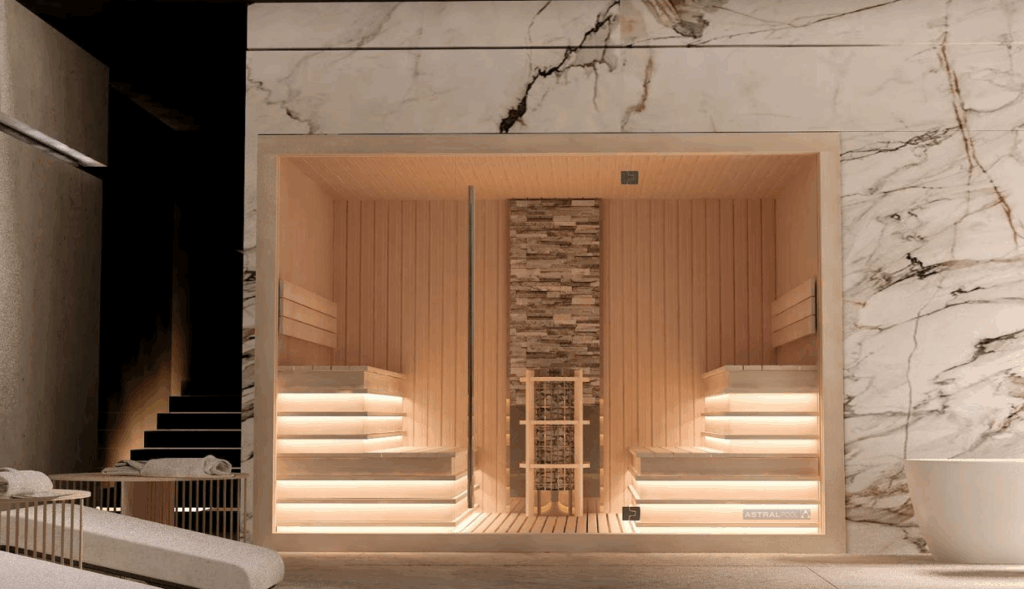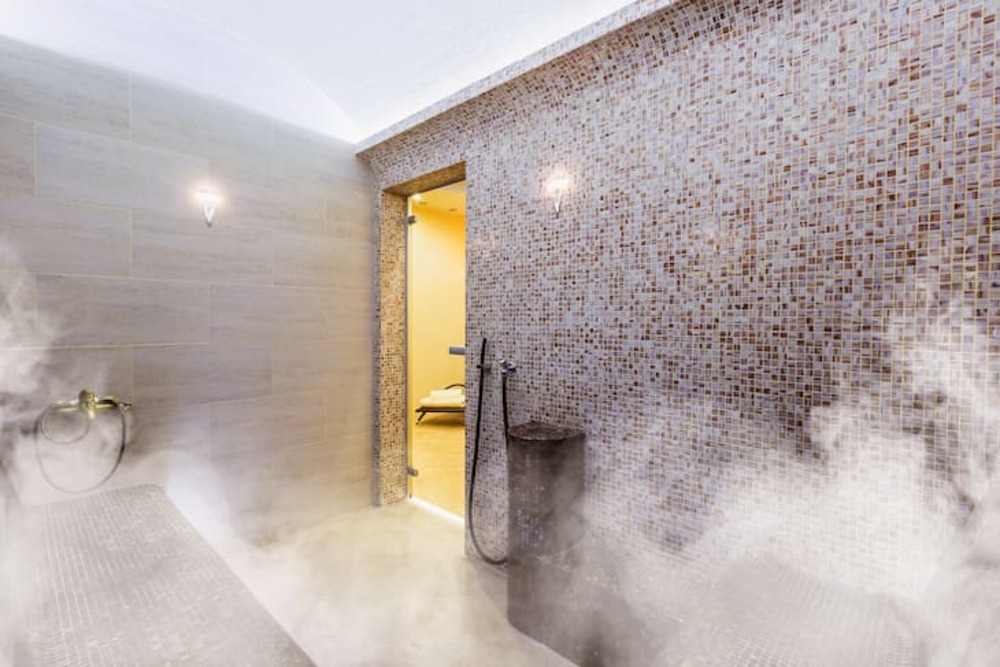The different types of sauna – dry, wet, infrared or hybrid – offer unique user experiences and health benefits, while also requiring diverse needs in terms of design and technology.
For wellness centers, saunas have become a strategic design element that, when approached purposefully, can define a space’s identity. A key example of this are wellness centers focusing on holistic therapies, which are building unique competitive advantages by tapping into elements like hydrotherapy and thermal therapies.
From this perspective, at Fluidra we understand that choosing the right sauna type involves more than aligning with certain aesthetic trends or a specific tradition: it’s about technology, materials, and adaptability to different user profiles and business models.
From this point of view, below we explore what the different types of saunas are and their implications both from a user point of view as well as a business’ perspective.
Dive deeper with the eBook
What are the types of saunas?
The four most common types of sauna today include dry, wet, infrared and hybrid saunas.
While we elaborated an in-depth guide for sauna types for wellness centers in a separate article, their different definitions can be summarized as follows:
- Dry saunas: also known as Finnish saunas, they present a low humidity level (around 5-20%) and high temperatures (around 70-90ºC). This provides a calming environment that helps in muscle relaxation and has been linked with cardiovascular benefits, reducing the risk of respiratory diseases and beneficial psychological effects.
- Wet saunas: sometimes referred to as steam rooms, hammam or Turkish baths, these spaces maintain very high humidity (around 100%) with temperatures not exceeding 50ºC. Steam baths are linked to benefits for mucus and nasal congestion, clearing pores and body detox, muscle relaxation, improving blood circulation, increasing oxygen levels and relieving mental fatigue.
- Infrared saunas: these types of saunas employ infrared lamps based on electromagnetic radiation to generate heat. A choice that allows them to operate at lower temperatures compared to dry saunas (usually between 40ºC – 60ºC), while also offering low humidity levels (between 10 – 35%). As such, they are associated with similar effects as the dry sauna (relaxation, elimination of toxins, improving blood flow, relieving pain and promoting physical recovery), all without the temperature levels that might feel too extreme for some users.
- Hybrid saunas: spaces such as biosaunas and salt saunas can be understood as part of this category. In the case of biosaunas, they offer a hybrid between the traditional Finnish sauna and the steam bath, as they represent an environment with a medium humidity level and a lower temperature than the traditional sauna. Additionally, during biosauna sessions essential oils are diffused, stimulating the users’ senses. Meanwhile, salt saunas involve the incorporation of Himalayan salts to surfaces, which are then ionized thanks to the environment’s temperatures and humidity. As a result, a saline and mineral environment is created that offers important benefits for respiratory, dermatologic, muscular and circulatory conditions, as well as stress relief.

What are the design considerations for the different types of saunas?
Beyond their specific health benefits, it’s important to consider all types of saunas have a direct influence on thearchitectural layout, technical infrastructure,and overalluser flow.
As such, each sauna variant comes with specific spatial and environmental requirements that must be considered during the design phase:
Design for flow: sauna placement and circulation
Saunas are not isolated elements, but part of a broader wellness circuit. From this perspective, designing with flow in mind means ensuring that users can transition smoothly between sauna types, showers, and rest areas without disrupting the therapeutic rhythm. A key movement to enhance both comfort and operational efficiency in wellness centers.
As such:
- Finnish saunas are often placed near cold plunge pools or relaxation areas to support thermal contrast therapy.
- Steam saunas require proximity to drainage systems and ventilation shafts.
- Infrared cabins can be integrated into smaller zones due to their compact footprint and lower heat output compared to other types of saunas.
Ventilation and climate control
Ventilation is critical for maintaining air quality and temperature stability, with the different types of saunas presenting unique requirements:
- Dry saunas need controlled airflow to prevent overheating and ensure oxygen circulation.
- Steam saunas require humidity extraction systems to avoid condensation and mold.
- Infrared saunas demand less ventilation but benefit from smart climate controls to allow users to customize their experience.
In this context, having access to integrated solutions for ventilation, heating, and humidity management such as the ones offered by Fluidra are key to tailor the different types of saunas and their spatial context.
Strategic planning for indoor vs. outdoor installations
The decision to install a sauna indoors or outdoors affects both the technical setup and the user experience, and is thus another key consideration when it comes to design:
- Indoor saunasoffer controlled environments and easier access to utilities, making them ideal for spas, gyms, and wellness hotels.
- Outdoor saunas, however, provide a nature-connected experience, often with panoramic views and enhanced relaxation. These types of saunas require weather-resistant materials, such as thermally modified wood and insulated glass, as well as considerations for drainage, foundation, and seasonal use.
An example of smart and versatile design, Fluidra’s modular sauna cabins are designed to adapt to the distinct needs of both indoor and outdoor settings, all while ensuring durability and aesthetic harmony.
Material selection considerations for the different types of saunas
Choosing the right materials is essential to ensure the longevity, safety, and comfort of sauna installations. This is why expert sauna builders like Fluidra prioritize materials that combine thermal performance, aesthetic appeal, and durability in high-humidity environments.
Some key materials to consider when building the different types of saunas include:
- Wood types for dry saunas, with Nordic spruce, hemlock, red alder, and thermo-treated woods for insulation and resistance to heat and humidity.
- Stone and tiles are ideal for steam environments due to their durability and ease of cleaning.
- Glass elements that add a contemporary touch and openness to infrared and salt saunas.

How to choose the right sauna for your project?
When selecting a sauna type, consider the following questions and their implications:
- What is the main user profile? Athletes, senior users or relaxation seekers will typically look for different experiences and be attracted to different sauna types. Make sure your choice aligns with their expectations by having a comprehensive picture of your customers’ needs.
- What are space and infrastructure opportunities and limitations? Consider the unique ventilation needs for all types of saunas, as well as requirements for humidity control and energy supply needs.
- How does each sauna type intersect with your business model? Operators looking for premium differentiation might look for the most modern, sophisticated types of saunas, or offer unique experiences rooted in tradition; meanwhile, those looking to offer hybrid experiences or maximize their ROI will similarly need to adapt their choice of sauna to their distinct business’ goals.
The types of saunas and their impact on business strategy
As seen above, selecting the right sauna type represents a strategic decision that affects not only the wellness experience but also theoperational successof a spa or wellness center.
As such, operators should ensure their choice aligns sauna technology with user needs and design goals.
A journey that is best taken with Fluidra: as specialists in wellness center design and development, we can help you create spaces that inspire, heal, and retain clients.
Frequently asked questions about types of saunas
Which type of sauna is the best?
The best type of sauna largely depends on the health effects and user experience you’re looking for. Broadly speaking, dry saunas are best for deep heat and detox; wet saunas, for respiratory cleansing and relaxation; infrared saunas, for gentle muscle recovery without extreme temperatures; and salt saunas for respiratory and skin benefits. Read more in our in-depth guide for sauna types for wellness centers.
How many sauna types are there?
Typically, types of saunas are described as four: dry saunas, wet saunas, infrared saunas and hybrid models.
What is healthier, steam or infrared sauna?
It depends on the expected health effects. On the one hand, the steam sauna offers unique health benefits due to being a high humidity environment, including deep hydration and relief from respiratory congestion. On the other hand, infrared saunas are usually linked with gentle but deep-penetrating heat that promotes muscle relaxation and pain relief. Both options are linked to detoxification benefits, as well as calming effects.
